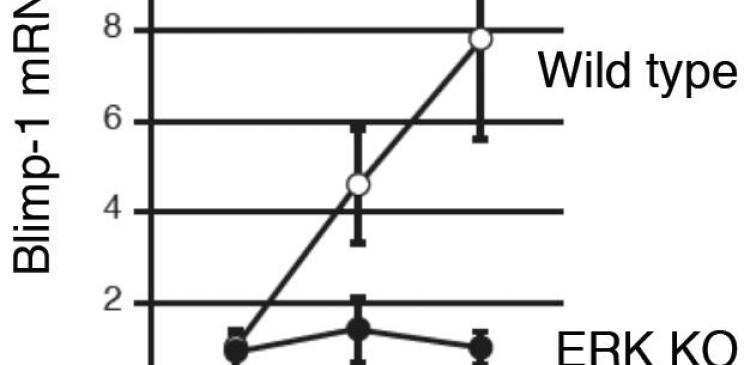Figure 1: ERK KO mice showed impaired IgG1 antibody production Wild type and ERK KO mice were immunized and the number of antigen-specific IgG1 antibody-secreting cells (ASC) (left) and antibody titer in sera was measured (right). Both the number of ASC and antibody titers were reduced in ERK KO mice.
The finding establishes a role for the extracellular signal-regulated kinase (ERK) signaling pathway in B cell differentiation, a key step toward the development of B cell-targeted drugs for treatment of autoimmune diseases and allergies.
As the only cells in the body that produce antibodies, B cells play an essential role in the immune system’s defense against bacteria and viruses. Differentiation of B cells into antibody-producing plasma cells is central to this role, initiating the production of antibodies whose targeted binding mechanism enables the immune system to identify and neutralize foreign objects. The mechanism underlying this differentiation process, however, remains unknown.
To better understand this mechanism, the research group focused on the signaling of the extracellular signal-regulated kinases (ERK), intracellular signaling molecules known to play an important role in the cell cycle and survival of immune cells. Hoping to glean insights into the role of ERKs in B cell differentiation into plasma cells, the researchers generated mice deficient in two different ERKs, ERK1 and ERK2, and studied the effect of this deficiency on the fate of B cells.
What they found confirmed that ERKs are in fact essential to B cell differentiation: B cells in mice without these key molecules were unable to form plasma cells (Figure 1). The researchers further traced this observation to a gene called Prdm1 encoding the protein BLIMP-1, increased expression of which leads to differentiation and proliferation of plasma cells in B cell immune response (Figure 2). ERKs, they discovered, phosphorylate the transcription factor Elk1, which leads to expression of Blimp-1 (Figure 3).
By elucidating the role of ERKs in B cell differentiation, the current research provides valuable insight into a little-understood area of immune response, promising advances in drug discovery and offering hope to autoimmune disease and allergy sufferers around the world.
For more information, please contact:
Tomohiro Kurosaki
Laboratory for Lymphocyte Differentiation
RIKEN Research Center for Allergy and Immunology
Tel: +81-(0)45-503-7019 / Fax: +81-(0)45-503-7018
Ms. Tomoko Ikawa (PI officer)
Global Relations Office
RIKEN
Tel: +81-(0)48-462-1225 / Fax: +81-(0)48-463-3687
Email: [email protected]
Reference:
T. Yasuda, K. Kometani, N. Takahashi, Y. Imai, Y. Aiba, T. Kurosaki, ERKs induce expression of the transcriptional repressor Blimp-1 and subsequent plasma cell differentiation. Sci. Signal. 4, ra25 (2011). DOI: 10.1126/scisignal.2001592
About the RIKEN Research Center for Allergy and Immunology
Our immune system forms a complex line of defense that normally protects us from diseases. Sometimes, however, the immune system becomes abnormal or fails. As a result, serious ailments, such allergic disorders, autoimmune diseases, graft-versus-host disease, AIDS, and cancer have emerged as important social and medical problems worldwide.
As a unique research institute different from universities or corporations, the RIKEN Research Center for Allergy and Immunology (RCAI) focuses on the development of innovative research platforms that will greatly contribute to the advances in science and medicine. These research platforms are utilized by researchers and clinicians in various universities and companies, and we work together with them to reach our final goal, to make lasting contributions to the people, medical care and society, by solving immunological problems.
Figure 3: ERKs are required for the phosphorylation of Elk1 In vitro stimulated cells (similar to Figure 2) were subjected to Western Blotting analysis. ERK KO B cells showed impaired Elk1 phosphorylation (left). B cells with the mutant Elk1, which are genetically modified not to be phosphorylated by ERKs, showed impaired Blimp-1 induction (right).





